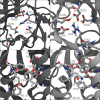Activity and Thermostability of GH5 Endoglucanase Chimeras from Mesophilic and Thermophilic Parents
- PMID: 30552196
- PMCID: PMC6384118
- DOI: 10.1128/AEM.02079-18
Activity and Thermostability of GH5 Endoglucanase Chimeras from Mesophilic and Thermophilic Parents
Abstract
Cellulases from glycoside hydrolase family 5 (GH5) are key endoglucanase enzymes in the degradation of diverse polysaccharide substrates and are used in industrial enzyme cocktails to break down biomass. The GH5 family shares a canonical (βα)8-barrel structure, where each (βα) module is essential for the enzyme's stability and activity. Despite their shared topology, the thermostability of GH5 endoglucanase enzymes can vary significantly, and highly thermostable variants are often sought for industrial applications. Based on the previously characterized thermophilic GH5 endoglucanase Egl5A from Talaromyces emersonii (TeEgl5A), which has an optimal temperature of 90°C, we created 10 hybrid enzymes with elements of the mesophilic endoglucanase Cel5 from Stegonsporium opalus (SoCel5) to determine which elements are responsible for enhanced thermostability. Five of the expressed hybrid enzymes exhibit enzyme activity. Two of these hybrids exhibited pronounced increases in the temperature optimum (10 and 20°C), the temperature at which the protein lost 50% of its activity (T50) (15 and 19°C), and the melting temperature (Tm ) (16.5 and 22.9°C) and extended half-lives (t1/2) (∼240- and 650-fold at 55°C) relative to the values for the mesophilic parent enzyme and demonstrated improved catalytic efficiency on selected substrates. The successful hybridization strategies were validated experimentally in another GH5 endoglucanase, Cel5 from Aspergillus niger (AnCel5), which demonstrated a similar increase in thermostability. Based on molecular dynamics (MD) simulations of both the SoCel5 and TeEgl5A parent enzymes and their hybrids, we hypothesize that improved hydrophobic packing of the interface between α2 and α3 is the primary mechanism by which the hybrid enzymes increase their thermostability relative to that of the mesophilic parent SoCel5.IMPORTANCE Thermal stability is an essential property of enzymes in many industrial biotechnological applications, as high temperatures improve bioreactor throughput. Many protein engineering approaches, such as rational design and directed evolution, have been employed to improve the thermal properties of mesophilic enzymes. Structure-based recombination has also been used to fuse TIM barrel fragments, and even fragments from unrelated folds, to generate new structures. However, little research has been done on GH5 endoglucanases. In this study, two GH5 endoglucanases exhibiting TIM barrel structure, SoCel5 and TeEgl5A, with different thermal properties, were hybridized to study the roles of different (βα) motifs. This work illustrates the role that structure-guided recombination can play in helping to identify sequence function relationships within GH5 enzymes by supplementing natural diversity with synthetic diversity.
Keywords: (βα)8-barrel structure; GH5 endoglucanase; hybrid enzymes; structure-based recombination; thermostability.
Copyright © 2019 American Society for Microbiology.
Figures





Similar articles
-
Functional and structural analysis of Pichia pastoris-expressed Aspergillus niger 1,4-β-endoglucanase.Biochem Biophys Res Commun. 2016 Jun 17;475(1):8-12. doi: 10.1016/j.bbrc.2016.05.012. Epub 2016 May 3. Biochem Biophys Res Commun. 2016. PMID: 27154222
-
Characterization of modular bifunctional processive endoglucanase Cel5 from Hahella chejuensis KCTC 2396.Appl Microbiol Biotechnol. 2014 May;98(10):4421-35. doi: 10.1007/s00253-013-5446-0. Epub 2013 Dec 17. Appl Microbiol Biotechnol. 2014. PMID: 24343767
-
A unique self-truncation of bacterial GH5 endoglucanases leads to enhanced activity and thermostability.BMC Biol. 2022 Jun 9;20(1):137. doi: 10.1186/s12915-022-01334-y. BMC Biol. 2022. PMID: 35681203 Free PMC article.
-
Glycosyl hydrolases family 5, subfamily 5: Relevance and structural insights for designing improved biomass degrading cocktails.Int J Biol Macromol. 2021 Dec 15;193(Pt A):980-995. doi: 10.1016/j.ijbiomac.2021.10.062. Epub 2021 Oct 16. Int J Biol Macromol. 2021. PMID: 34666133 Review.
-
Hyperthermophilic enzymes: sources, uses, and molecular mechanisms for thermostability.Microbiol Mol Biol Rev. 2001 Mar;65(1):1-43. doi: 10.1128/MMBR.65.1.1-43.2001. Microbiol Mol Biol Rev. 2001. PMID: 11238984 Free PMC article. Review.
Cited by
-
Identification and Mutation Analysis of Nonconserved Residues on the TIM-Barrel Surface of GH5_5 Cellulases for Catalytic Efficiency and Stability Improvement.Appl Environ Microbiol. 2022 Sep 13;88(17):e0104622. doi: 10.1128/aem.01046-22. Epub 2022 Aug 24. Appl Environ Microbiol. 2022. PMID: 36000858 Free PMC article.
-
Engineering Robust Cellulases for Tailored Lignocellulosic Degradation Cocktails.Int J Mol Sci. 2020 Feb 26;21(5):1589. doi: 10.3390/ijms21051589. Int J Mol Sci. 2020. PMID: 32111065 Free PMC article. Review.
-
Plant Terpenoid Permeability through Biological Membranes Explored via Molecular Simulations.J Phys Chem B. 2023 Feb 9;127(5):1144-1157. doi: 10.1021/acs.jpcb.2c07209. Epub 2023 Jan 30. J Phys Chem B. 2023. PMID: 36717085 Free PMC article.
-
Thermostability improvement of sucrose isomerase PalI NX-5: a comprehensive strategy.Biotechnol Lett. 2023 Jul;45(7):885-904. doi: 10.1007/s10529-023-03388-6. Epub 2023 May 18. Biotechnol Lett. 2023. PMID: 37199887
-
A comprehensive review on microbial hyaluronan-degrading enzymes: from virulence factors to biotechnological tools.Bioresour Bioprocess. 2024 Dec 25;11(1):114. doi: 10.1186/s40643-024-00832-x. Bioresour Bioprocess. 2024. PMID: 39722064 Free PMC article. Review.
References
-
- Srivastava N, Srivastava M, Mishra PK, Gupta VK, Molina G, Rodriguez-Couto S, Manikanta A, Ramteke PW. 2018. Applications of fungal cellulases in biofuel production: advances and limitations. Renew Sustain Energy Rev 82:2379–2386. doi:10.1016/j.rser.2017.08.074. - DOI
Publication types
MeSH terms
Substances
LinkOut - more resources
Full Text Sources

